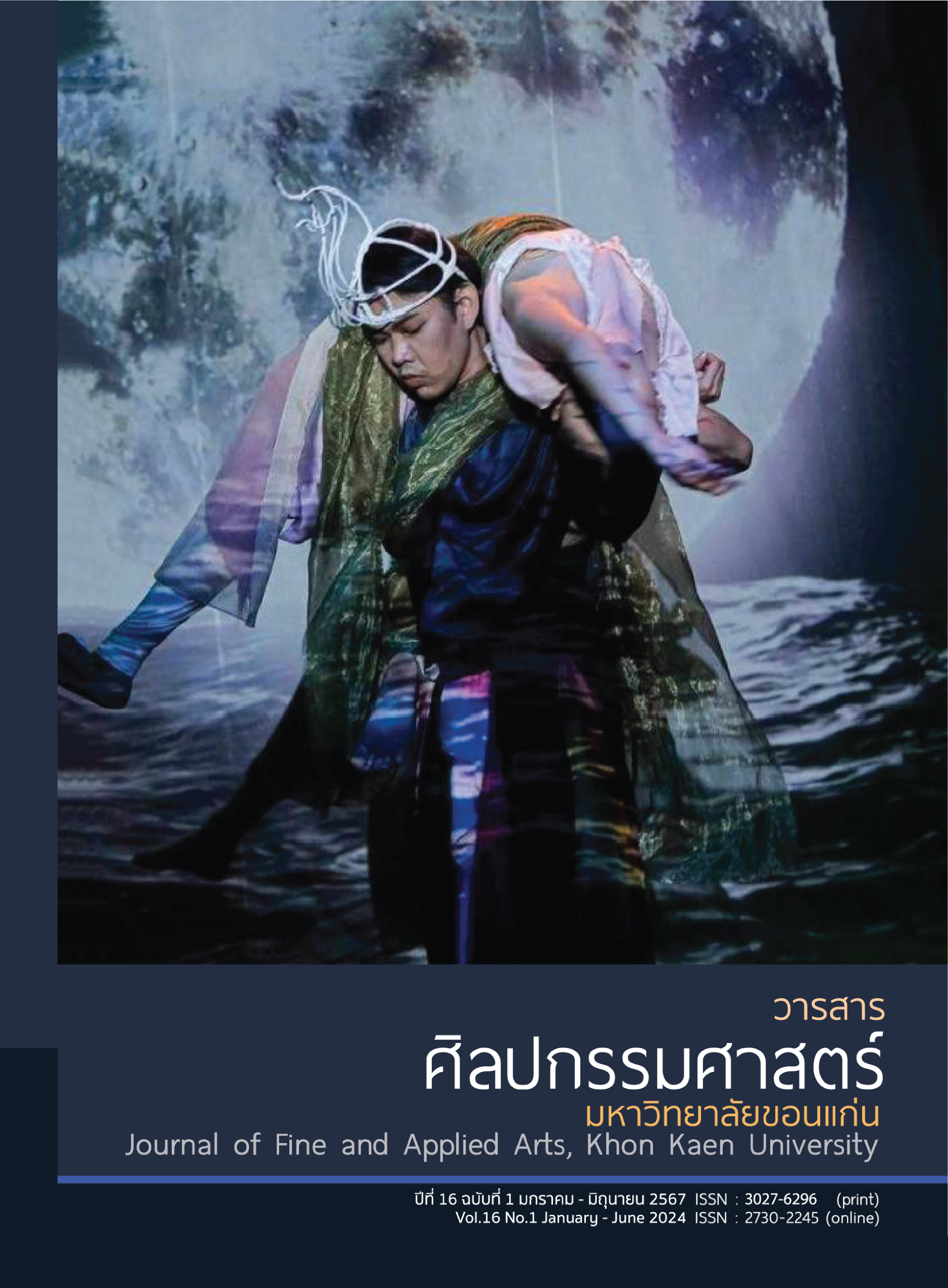Styles and Beliefs in Chinese Landscape Painting
Main Article Content
Abstract
The study on “Styles and Beliefs in Chinese Landscape Paintings” aims to study the history of Chinese landscape paintings in Nukit Racha Boriharn Chinese Mansion, Bangkok, to study styles and beliefs in Chinese landscape paintings in Nukit Racha Boriharn Chinese Mansion, Bangkok. There are 2 types of tools used: document data collection and field data collection. Then, the data was analyzed according to the data collection, including data analysis that summarizes the data into categories to find answers according to the objectives of the research and data analysis from non-participant observations using culture diffusion theory, aesthetic theory and semiotic theory to review and verify the information to be accurate. Then, descriptive information was also presented along with visual information. According to the research results, it was found that Nukit Racha Boriharn Chinese Mansion is a Chinese architectural building located within the area of the Front Palace, (Wang Na) or the Bangkokg National Museum in Phra Nakhon District at present, built during the reign of King Pinklao Chao Yuhua, to offer to Phra Wisut Varee (Mali) when he came to stay in the royal palace. The Nukit Rajabharat Building is a one-story building made of bricks and cement. The width is 4.50 meters, the length is 7.8 meters, and the height of the spine is 4.50 meters. There is a Chinese architectural style, gable, pediment and roof ridge, painted with Pudtan flowers and Hong Fa, styled with Chinese patterns. Inside the cabin, there are mural paintings on all 3 sides, telling the story of the ancient Chinese chronicle "Hong Sin", which was written by the skill of Chinese craftsmen in the period of Krom Phra Ratchawang Bowon Wichaicha, the viceroy in the reign of King Rama V. The murals in the interior of the Chinese mansion titled "Hong Sin" are classified as Chinese mythological novels. It has been translated into Thai since the early Rattanakosin period. The "Hong Sin" painting is a large-scale painting that has been beautifully and splendidly created by a Chinese artist. Each scene, each episode has a continuous, seamless connection, reflecting the traditional Chinese arts. In the picture, there are also Chinese characters indicating the names of the protagonists, the name of the mechanical camp, the name of the cave, the name of the place, especially the name of the mountain and scenery. Overall, on each side of the mural, it was found that the composition and color of the picture were beautiful, focusing on movement and the dimensions of the image with black lines used to bold the drawing lines. Partitioning or dividing episodes to tell stories, scenes are divided by using natural scenery using steep mountain scenes, a large, twisted tree, serpentine river, and clouds that look like clusters with mass. These can, therefore, be regarded as having an important role in determining the direction, structure, boundary, and composition of the painting "Hong Sin". In addition, the "Hong Sin" painting also plays an important role as a learning center and a source of studying Chinese traditions as well as principles of morality and customs, with content that focuses on courage, sacrifice and patience, especially the honesty of the Chinese people, which have been cultivated from the principles of "Tao and Confucius" and eventually became ingrained and became an important character of the Chinese until today. In conclusion, the mural painting "Hong Sin" is a beautiful painting in accordance with the Chinese traditional painting. The painter created it for the purpose of being a picture that primarily conveys virtue, courage and sacrifice.
Article Details

This work is licensed under a Creative Commons Attribution-NonCommercial-NoDerivatives 4.0 International License.
Content and information in articles published in the Journal of Fine and Applied Arts of Khon Kaen University is regarded as the opinion and sole responsibility of the author(s) directly; therefore, editors are not obliged to agree to or share any responsibility with regard to the content and information that appears within these articles.
All articles, information, content, image, etc. that have been published in the Journal of Fine and Applied Arts of Khon Kaen University is the copyright of the Journal of Fine and Appllied Arts of Khon Kaen University. Any person or organization who wishes to distribute all or parts of the articles for further dissemination or other usage must first receive permission from the Journal of Fine and Applied Arts of Khon Kaen University before proceeding to do so.
References
กำจร สุนพงษ์ศรี. (2531). ประวัติศาสตร์ศิลปะจีน. กรุงเทพฯ : สำนักพิมพ์จุฬาลงกรณ์มหาวิทยาลัย.
ซู จิน เซิง. (2564). การศึกษาเทคนิคการใช้สีของชาวจีนโบราณ. เซี่ยงไฮ้ : คณะศิลปกรรมศาสตร์ มหาวิทยาลัยเซี่ยงไฮ้ ประเทศจีน.
ต้วน ลี เซิง และคณะ. (2543). ความเป็นมาของวัดจีนและศาลเจ้าจีนในประเทศไทย. กรุงเทพฯ : ส่องสยาม.
พิเชษฐ์ เปียร์กลิ่น. (2558). การศึกษาเปรียบเทียบสุนทรียภาพของภาพเขียนหมึกดำรูปทิวทัศน์: กรณีศึกษาจากลัทธิเต๋าและนิกายเซนของจีนและญี่ปุ่น. วารสารศิลป์ พีระศรี, 3(1), 163-229.
ภูริวรรณ วรานุสาสน์. (2559). สัญลักษณ์และเรื่องเล่าจากจิตรกรรมศาลเจ้าจีน : กรณีศึกษาจากศาลเจ้าบึง พระ ต.บึงพระ อ.เมือง จ.พิษณุโลก. วารสารจีนวิทย, 10, 24-47.
ยง จื้อ. (2549). หนังสือการเรียนศิลปะจีน. ปักกิ่ง : มหาวิทยาลัยปักกิ่ง.
สู ทั่น. (2559). การเขียนภาพวาดทิวทัศน์. เจ้อเจียง : สถาบันศิลปะชนชาติจีนเจ้อเจียง.


